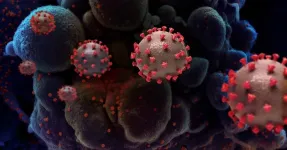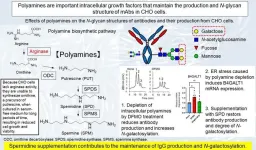(Press-News.org) In early 2020, severe acute respiratory syndrome coronavirus 2 (SARS-CoV-2), a highly contagious and pathogenic virus, made its alarming debut and quickly spread worldwide, causing the novel coronavirus (COVID-19) pandemic that threatened human health and public safety. While the world was brought to a standstill, hospitals and health care systems entered unchartered territory and quickly adapted to the evolving health crisis to care for their community and keep potentially sick patients and health care workers from spreading the virus.
The magnitude of response involved the reinforced universal masking of health care workers and patients at the hospital and regular SARS-CoV-2 testing of all health care workers and patients upon admission, regardless of symptoms, and strict isolation protocols for those infected with the virus.
Approximately four years after the pandemic was declared, researchers at University of California San Diego School of Medicine used high end technology and an innovative approach to evaluate the effectiveness of those prevention measures implemented in the health care setting during the last three waves of the pandemic.
The study, published in the January 16, 2024, online edition of Clinical Infectious Diseases, was a first of its kind to use information from electronic health and contact tracing records to closely analyze the genetic makeup of the virus combined with the comparison of how the diverse strains were physically being spread among patients and health care workers in the hospital.
Researchers found that the implemented infection prevention parameters in the health care setting, including ventilation standards of at least five clean air changes per hour, combined with universal masking, prevented most SARS-CoV-2 transmissions. In patients who tested positive for the virus, personal protective equipment (PPE) shielded and virtually eliminated health care associated transmission.
“When the pandemic started, it was scary because initially we did not have rapid diagnostic nor treatments available, and we did not fully understand how the virus was transmitted or if our infection prevention protocols were adequate,” said Francesca Torriani, MD, senior author of the study, and program director of Infection Prevention and infectious disease specialist at UC San Diego Health.
“Therefore, the potential implications of the virus and the welfare of our workforce and patients was an utmost concern. I witnessed health care workers fearful of contracting the virus at work and potentially infecting their loved ones at home.”
Torriani adds that limiting the spread of infection and blocking the virus at the source became the highest priority.
“In response to the progressing pandemic and with the trust and support from executive leadership at UC San Diego Health, we learned many life-saving lessons and strengthened infection prevention control measures to reduce the risk of transmission between patients and health care workers. The swift adoption and modification of infection prevention protocols in health care were felt to be an opportunity for deeper exploration of the effectiveness of our procedures.”
The researchers took an innovative approach never used before to evaluate the different variants of the samples to identify if they were temporarily or physically near one another, suggesting health care transmission. Electronic health record data of patients, whose identities were protected throughout the study, and metadata about staff access and movement to these records, accompanied by a robust contact tracing program, were used to classify, isolate and assess individuals exposed to specific strains of the virus.
“While the virus strains were very distinguishable in the second and third wave of the pandemic, during the explosive and homogenous Omicron wave, we found that we could not rely on genetic data alone,” said Christopher Longhurst, MD, co-author of the study, executive director of Jacobs Center for Health Innovation, and chief medical officer and chief digital officer at UC San Diego Health.
“We had to dive deeper into the electronic documentation and social network analysis, such as individuals with similar virus strains, and considering their physical interaction in the hospital, to determine what really happened and how the virus was being spread.”
Researchers examined the genetic makeup of SARS-CoV-2 during three consecutive waves and compared how closely a person’s genetic variant was related to another’s.
The study involved the collection of 12,933 virus samples from 35,666 patients and health care professionals from November 1, 2020 to February 27, 2022.
“Even when hundreds of health care workers were becoming infected every week during the peak of the Omicron wave, we found that they were no more likely to acquire the virus in the hospital system,” said Joel Wertheim, PhD, co-senior author of the study and associate professor at UC San Diego School of Medicine. “The outcomes reveal the hidden patterns of viral transmission.”
The results from both the genetic and social networking analysis showed that while universal masking was key to prevent transmissions, airborne negative pressure rooms, universal N95 respirator masks or even closing the door of a patient’s room were not essential elements to protect against transmission in the health care setting.
In fact, most transmissions occurred outside of the health care setting, physical contact in the community, between households or when universal masking was not followed in the setting of unrecognized SARS-CoV-2 infection. Viral transmission was more likely to occur in shared spaces, such as breakrooms or lobbies.
“Our analysis really highlights that our health care system, with its safety measures including ventilation standards, robust viral testing, and early implementation of universal masking, was able to protect health care workers and patients during the pandemic,” said Shira Abeles, MD, co-author of the study, associate professor in the Department of Medicine at UC San Diego School of Medicine and infectious disease specialist at UC San Diego Health.
Longhurst adds the type of technological approach used can be a model for future studies and a tool deployed for epidemics of highly contagious infectious diseases.
“The pandemic has shown us what’s at stake. This novel methodology, combining a digital social network derived from electronic health record data with genomic analysis of viral strains, can be used again in the future to model spread of health care associated infections,” said Longhurst.
Co-authors of the study include: Jocelyn Keehner, UCSF; Lucy Horton, Frank E. Myers, Lindsay Riggs-Rodriguez, Mohammed Ahmad, Sally Baxter, Aaron Bussina, Kalen Cantrell, Priscilla Cardenas, Peter De Hoff, Robert El-Kareh, Jennifer Holland, Daryn Ikeda, Kirk Kurashige, Louise Laurent, Andrew Lucas, David Pride, Shashank Sathe, Allen Tran, Tetyana Vasylyeva, Gene Yeo, Rob Knight, all at UC San Diego.
Funding support for the study came, in part, from UC San Diego Health and Jacobs Center for Health Innovation.
END
Innovative COVID-19 analysis supports prevention protocols in health care settings
Using high-tech contact tracing and COVID-19 genetic data, researchers prove certain prevention measures protect health care workers and patients from contracting the virus with vast majority of transmission happening outside of hospital setting
2024-01-16
ELSE PRESS RELEASES FROM THIS DATE:
New study mapping entire genome of oral stem cells opens new doors for regenerative medicine
2024-01-16
Cambridge, Mass., Jan. 16, 2024 - A team of researchers from the ADA Forsyth Institute and University of North Carolina (UNC), Chapel Hill used single-cell transcriptomic analysis to successfully map dental pulp stem cells (DPSC) and periodontal ligament stem cells (PDLSC) and found remarkable differences between them. The study, which appeared in the Journal of Dental Research, provides the most detailed analysis of these stem cells to date, identifying the entire genome of the stem cells and their potential differentiation trajectories.
“Dental pulp and periodontal ligament stem cells both have the potential to develop into any type of cell in the body,” ...
Do violent video games numb us towards real violence?
2024-01-16
Neuroscientists from the University of Vienna and the Karolinska Institute in Stockholm have investigated whether playing violent video games leads to a reduction in human empathy. To do this, they had adult test subjects play a violent video game repeatedly over the course of an experiment lasting several weeks. Before and after, their empathic responses to the pain of another person were measured. It was found that the violent video game had no discernible effect on empathy and underlying brain activity. These results have now been published in the renowned journal eLife.
Video games have become an integral part of the everyday life of many ...
Novel AI platform matches cardiologists in detecting rheumatic heart disease
2024-01-16
WASHINGTON (Jan. 16, 2024) – Artificial intelligence (AI) has the potential to detect rheumatic heart disease (RHD) with the same accuracy as a cardiologist, according to new research demonstrating how sophisticated deep learning technology can be applied to this disease of inequity. The work could prevent hundreds of thousands of unnecessary deaths around the world annually.
Developed at Children’s National Hospital and detailed in the latest edition of the Journal of the American Heart Association, the new AI system combines the power of novel ultrasound probes with portable electronic ...
Researchers examine accuracy of adult body weight estimates in the emergency department
2024-01-16
Knowing a patient’s weight is necessary for many weight-based medications such as thrombolytics, anticoagulants and numerous cardiovascular medications. Scaling drugs to a patient’s weight prevents adverse events from overtreatment and treatment failure due to underdosing. Inaccurate weight estimations may lead to inaccurate drug doses, which could cause patient harm.
However, in the emergency department (ED) during resuscitative care, measuring weight is often impossible. Moreover, little is known about the relative accuracy of different methods currently used to weigh patients during emergency care. For example, ...
Conscience announces first success in open science challenge to predict “hits” for Parkinson’s disease drugs
2024-01-16
TORONTO (16 January 2024) – As part of its pioneering approach to drug discovery, the Canadian nonprofit Conscience announced today that its first open science competition has resulted in the identification of seven promising molecules, or “hits,” that show potential for new, more effective drugs for familial Parkinson’s disease.
This first competition in Conscience’s CACHE (Critical Assessment of Computational Hit-Finding Experiments) Challenge series was funded by The ...
Can recycled pacemakers from the U.S. save lives overseas? Study seeks to find out
2024-01-16
From inside an operating room in Barquisimeto, Venezuela, electrophysiologist Maria Milagros Arends, M.D., threads wires from a pacemaker through the veins and into the heart muscle of a patient.
This pacemaker, which regulates the heartbeat and can be lifesaving, was once in the body of another person. It has been recycled, or “reconditioned”— donated, tested, sterilized and shipped from the United States to the South American country for implantation.
“We have a waiting list of around 300 people who could potentially lose their lives in less than a month,” ...
Higher acetaminophen intake in pregnancy linked to attention deficits in young children
2024-01-16
CHAMPAIGN, Ill. — A new study links increased use of acetaminophen during pregnancy – particularly in the second trimester – to modest but noticeable increases in problems with attention and behavior in 2-, 3- and 4-year-olds. The study adds to a growing body of evidence linking the frequent use of acetaminophen in pregnancy to developmental problems in offspring.
The findings are detailed in the journal Neurotoxicology and Teratology.
The research is part of the Illinois Kids Development Study at the University of Illinois Urbana-Champaign, which explores how environmental ...
Manipulating polyamines to enhance antibody efficacy: A novel approach in biotechnology
2024-01-16
Monoclonal antibodies (mAbs) are laboratory-designed proteins that mimic the immune system's antibodies. To date, many therapeutic mAbs belonging to the immunoglobulin G (IgG) class of antibodies, have been approved for the treatment of cancer and autoimmune diseases. Cell lines such as the Chinese hamster ovary (CHO) cells are generally used to produce mAbs. Notably, the production and manufacture of mAbs are regulated by critical quality attributes (CQAs) to ensure their safety and efficacy in treatment.
An important CQA for mAbs is the N-linked glycosylation present at a specific position (Asn297). N-linked glycans consist of N-acetylglucosamine (GlcNAc), mannose (Man), fucose ...
New initiative focuses on oral health clinicians in prevention and early detection of heart disease
2024-01-16
DALLAS, JANUARY 16, 2024 — A patient’s oral health can be an indicator of overall health and well-being. Research shows that chronic gum inflammation may be associated with other chronic diseases including coronary artery disease and diabetes.[1] In addition, certain bacteria that live in the mouth can travel through the bloodstream to other parts of the body, including the heart and lungs. Oral bacteria, including viridans group streptococcal (VGS), can cause infective endocarditis, an infection of the inner ...
Cannabis activates specific hunger neurons in brain
2024-01-16
PULLMAN, Wash. – While it is well known that cannabis can cause the munchies, researchers have now revealed a mechanism in the brain that promotes appetite in a set of animal studies at Washington State University.
The discovery, detailed in the journal Scientific Reports, could pave the way for refined therapeutics to treat appetite disorders faced by cancer patients as well as anorexia and potentially obesity.
After exposing mice to vaporized cannabis sativa, researchers used calcium imaging technology, which is similar to a brain MRI, to determine how their brain cells responded. They observed that cannabis activated a set of cells in the hypothalamus when the rodents anticipated ...
LAST 30 PRESS RELEASES:
Tracing the quick synthesis of an industrially important catalyst
New software sheds light on cancer’s hidden genetic networks
UT Health San Antonio awarded $3 million in CPRIT grants to bolster cancer research and prevention efforts in South Texas
Third symposium spotlights global challenge of new contaminants in China’s fight against pollution
From straw to soil harmony: International team reveals how biochar supercharges carbon-smart farming
Myeloma: How AI is redrawing the map of cancer care
Manhattan E. Charurat, Ph.D., MHS invested as the Homer and Martha Gudelsky Distinguished Professor in Medicine at the University of Maryland School of Medicine
Insilico Medicine’s Pharma.AI Q4 Winter Launch Recap: Revolutionizing drug discovery with cutting-edge AI innovations, accelerating the path to pharmaceutical superintelligence
Nanoplastics have diet-dependent impacts on digestive system health
Brain neuron death occurs throughout life and increases with age, a natural human protein drug may halt neuron death in Alzheimer’s disease
SPIE and CLP announce the recipients of the 2025 Advanced Photonics Young Innovator Award
Lessons from the Caldor Fire’s Christmas Valley ‘Miracle’
Ant societies rose by trading individual protection for collective power
Research reveals how ancient viral DNA shapes early embryonic development
A molecular gatekeeper that controls protein synthesis
New ‘cloaking device’ concept to shield sensitive tech from magnetic fields
Researchers show impact of mountain building and climate change on alpine biodiversity
Study models the transition from Neanderthals to modern humans in Europe
University of Phoenix College of Doctoral Studies releases white paper on AI-driven skilling to reduce burnout and restore worker autonomy
AIs fail at the game of visual “telephone”
The levers for a sustainable food system
Potential changes in US homelessness by ending federal support for housing first programs
Vulnerability of large language models to prompt injection when providing medical advice
Researchers develop new system for high-energy-density, long-life, multi-electron transfer bromine-based flow batteries
Ending federal support for housing first programs could increase U.S. homelessness by 5% in one year, new JAMA study finds
New research uncovers molecular ‘safety switch’ shielding cancers from immune attack
Bacteria resisting viral infection can still sink carbon to ocean floor
Younger biological age may increase depression risk in older women during COVID-19
Bharat Innovates 2026 National Basecamp Showcases India’s Most Promising Deep-Tech Ventures
Here’s what determines whether your income level rises or falls
[Press-News.org] Innovative COVID-19 analysis supports prevention protocols in health care settingsUsing high-tech contact tracing and COVID-19 genetic data, researchers prove certain prevention measures protect health care workers and patients from contracting the virus with vast majority of transmission happening outside of hospital setting





